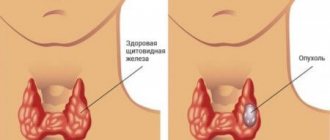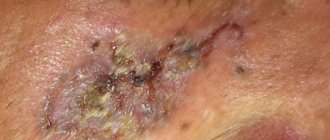Galina Davydova
Get up early, douse yourself with ice water, do exercises, eat only healthy foods
calendar_today
June 11, 2017
visibility
743 views
Throat and larynx cancers are uncommon cancers. Most often, this may be due to a genetic predisposition to malignant neoplasms along with exposure to harmful factors such as smoking and alcohol abuse. Tobacco smoke and alcohol not only contain many carcinogenic substances, but also have an irritating effect on the mucous membrane of the oropharynx, which also contributes to the development of oncological processes.
However, it cannot be said with certainty that only these two factors are the cause of throat and larynx cancer. Along with them, various occupational hazards increase the likelihood of malignant degeneration of cells - for example, dusty premises, the presence of sprayed carcinogenic substances in the air at the workplace, etc. Also, the risk of developing laryngeal cancer is increased in those people who already have a history of malignant neoplasms, even in those cases where remission was achieved.
Types of throat cancer
The classification is formed based on several factors. Depending on the location, there are cancers of the nasopharynx, oropharynx and laryngopharynx. Another type of typology based on localization is tumor formation of the anterior or posterior wall of the pharynx.
According to histological characteristics, types are distinguished:
- • Endophytic - bleeding formation with a gray coating. It is most often localized on the tonsils, causing their enlargement.
- • Exophytic - a bump hidden by epithelium. Its surface is partially ulcerated and bleeds with minor mechanical damage.
There is also squamous cell carcinoma of the pharynx, which can be:
- • differentiated (keratinizing) - takes a long time to develop;
- • undifferentiated (non-keratinizing) - rapidly progresses;
- • poorly differentiated;
- • glandular-squamous.
According to the TNM classification, where in the description T is the primary tumor, N is regional lymph nodes, M is distant metastases, the following is determined:
- Characteristics of the primary tumor:
- • X: not enough information to determine the shape;
- • 0: precancerous condition;
- • Is: sarcoma (non-invasive cancer of the pharynx).
- Metastasis in regional lymph nodes:
- • 0: no metastases;
- • 1: present in one of the nodes (up to 3 cm);
- • 2: present in one knot (up to 6 cm) or in knots on both sides, regardless of size.
- Distant metastasis:
- • 0: absent;
- • 1: present.
The TNM system is generally accepted and provides complete and understandable information in the medical history. On its basis, diagnostic and therapeutic measures are prescribed and carried out.
Special instructions for treatment
According to research, if the supraglottic region is affected and the process extends to stage T1N0M0, it is better to give preference to irradiation (the cure rate reaches 95%, the function of the larynx is preserved). For T2N0M0 and similar localizations, organ-sparing surgery is indicated, because up to 80% of relapses after irradiation are associated with damage to these particular laryngeal structures.
If the folded area is affected and stage T1N0M0 is recorded, therapy begins with irradiation. With this method, the cure rate is 75-78%, taking into account which it is necessary to carry out an initial assessment of the effectiveness of therapy at a dose of 40 Gy. If regression of the tumor is less than 70%, then surgical intervention – chordectomy – is possible. When the tumor has spread to the anterior commissure and second vocal fold, laryngeal resection is performed, because in this case the long-term results are better than with radiation.
Chemotherapy does not improve treatment outcomes for stage T1-2N0M0.
When treating locally advanced pathology at stage T3N0M0-T4N0M0, the greatest effectiveness was shown by the use of a combined technique with different sequences of irradiation and surgery, because in this case, 70-73% of patients achieve five-year survival. However, this involves performing a laryngectomy, which disables the patient.
If the patient has contraindications to surgery, therapy begins with radiation. If the cancer is advanced T3-T4, then the options for radiation therapy are limited. Moreover, even if operations are possible, they are crippling in nature. An option for organ-preserving treatment of locally advanced pathology or the hypopharynx may be a combination of induction chemotherapy according to the PF regimen (Cisplatin and 5-fluorouracil) with further irradiation if there is a response to therapy. If it is not observed, a laryngectomy is performed.
Pharynx cancer: symptoms and signs with photos
At the initial stage, the disease is asymptomatic. During this period, complaints arise that are characteristic of the most primitive infectious diseases of the ENT organs: a sore throat, a burning sensation and a sore sensation after thermal or mechanical exposure, and pink spots appear. Remission occurs periodically, but soon the symptoms become obvious and similar to purulent tonsillitis: the spots enlarge, ulcerate, and bleed when pressed. These are visible warning signs of pharyngeal cancer. If they are not treated, the process inevitably turns into cancer, the first symptoms of which are long-term non-healing wounds.
In the early stages, changes occur in the mucous membrane: it becomes thinner and becomes covered with a persistent whitish or grayish coating. Without treatment, the primary symptoms intensify and the patient’s well-being worsens.
Late signals include:
- • enlarged or deepened visible ulcers;
- • a lump on the outside of the neck or growing into the lumen;
- • pain in the mouth, periodic numbness;
- • change or loss of voice.
The beginning of the disintegration of tumor tissue is expressed by bad breath, coughing up mucus and lumps. The clinical picture is complemented by intoxication, the manifestations of which are lack of appetite, weakness, fever, chills, rapid pulse, weak breathing, profuse sweating.
Externally, pharyngeal cancer rarely manifests itself, even in its advanced form: its consequences are reflected in the speech apparatus, but there are no spots on the skin, and there is no rash on the body.
Symptoms
The most important and most common symptom of laryngeal cancer is hoarseness. In fact, it occurs in almost all cases. However, the stage at which this symptom appears depends on the location of the tumor. Dysphonia of varying degrees (from slight hoarseness to complete aphonia) is based on a purely physical reason - non-closure of the vocal cords during phonation. The presence of a small tumor on the free edge of the true vocal cord is sufficient for dysphonia to appear in a clear form. Consequently, tumors of the true vocal cord are already characterized by this symptom in the first stage of their development.
Tumors that impair the mobility of the true vocal cords also cause dysphonia. However, such tumors do not belong to stage I of the disease, but to stage II or even stage III. Impaired movements of the true vocal cords depend not only on damage to them, but also on infiltration of the subglottic region, as well as on the presence of exophytic tumors in the supraglottic space and, finally, on processes located outside the larynx, but putting pressure on the recurrent nerve. From here it becomes clear that hoarseness can appear at any stage of development of laryngeal cancer and is caused by different localization of the process and is not always the initial symptom of the disease. In any case, the appearance of this symptom requires clarification of its cause if hoarseness continues for more than 2 weeks.
The second important symptom of laryngeal cancer is dyspnea. It is almost never early and is absent in the first stage of the disease at any location. However, its significance is great, since this symptom is life-threatening for the patient. Initially, dyspnea is only a subjective symptom: the patient feels a lack of air during physical exertion. Over time, it becomes noticeable to others. It is based on a narrowing of the airway at some level of the larynx. Most often, difficulty breathing is observed with exophytic tumors on the vocal cords, on the false vocal cords and on the laryngeal surface of the epiglottis. However, only when the corresponding half of the larynx is immobile does this symptom develop fully. However, there is one place in the larynx where there are no exophytic tumors, but the development of endophytic tumor infiltration gives a pronounced picture of dyspnea - this is the subglottic space. True, usually in these cases the development of a tumor is accompanied by immobility of one vocal cord. If no tumor is visible during laryngoscopy and all parts of the larynx appear normal, then the suspicion that the tumor is in the subglottic space becomes likely. Such a suspicion requires additional research methods to clarify the diagnosis.
When a malignant tumor of the larynx extends beyond the larynx, into the hypopharynx - into the piriform sinus or beyond the plate of the cricoid cartilage, paralysis of the recurrent nerve may occur, as well as respiratory failure.
Dysphagia, as a symptom of laryngeal cancer, occurs in certain cases when a tumor protruding into the lumen interferes with the passage of food. This occurs with tumors developing in the cervical pharynx or esophagus. In other cases, swallowing problems may occur with tumors located at the entrance to the larynx or its vestibular region.
The symptom of enlargement of the cartilaginous skeleton of the larynx and the area of the hypoglossoid ligament appears when a tumor affects one or another cartilage or when the tumor fills the preepiglottic space. As a rule, tumor growth into cartilage is accompanied by an inflammatory process, which is manifested by pain when palpated. Most often, perichondritis of the epiglottis, arytenoid cartilages and, less commonly, the thyroid and cricoid cartilages are observed. This is a formidable symptom that must be eliminated even before attempting to eliminate the tumor process. Carrying out anti-inflammatory treatment with large doses of antibiotics and sulfonamides makes it possible to use radiation therapy without complications.
The symptom of cough in case of laryngeal cancer has different meaning in different cases. The location of the tumor in the upper floor of the larynx and in the area bordering the pharynx often leads to a series of paresthesias that cause short coughing attacks. Cough with a tumor of the larynx may also depend on a violation of the act of swallowing. Finally, a cough can be caused by the patient’s aspiration of tissue decay of a tumor or blood from small hemorrhages from an ulcerated tumor.
Enlarged lymph nodes in the neck with laryngeal cancer should attract the attention of a doctor. It can have different meanings, depending on the localization of this process in one or another part of the larynx. Thus, the presence of a dense, round, enlarged lymph node on the thyroid cricoid membrane, as well as below, in front of the trachea or to the side of the trachea along the recurrent nerve, gives reason to suspect with a high degree of probability the presence of cancer in the subglottic space. Dense lymph nodes at the level of the division of the common carotid artery indicate metastases of advanced cancer of the glottis area. However, more often, enlarged lymph nodes located throughout the neck - from the posterior belly of the digastric muscle to the clavicle - are affected by metastases of vestibular cancer or secondary cancer from the larynx or a primary tumor of the cervical pharynx and esophagus.
Enlarged and dense lymph nodes affected by metastases can be painful if there is a concomitant infection.
The symptom of rounding of the anterior angle of the thyroid cartilage mostly indicates the filling of the preepiglottic space with a tumor, which also occupies the anterior angle of the thyroid cartilage.
The feeling of crepitus with horizontal displacement of the thyroid cartilage is normal. The absence of such crepitus is often pathognomonic for laryngopharyngeal cancer.
The symptom of impaired mobility of the larynx has its own gradations, but is never early. Vocal cord cancer in the third stage of its development, when the tumor grows into the muscle, causes immobility of the ligament, while the arytenoid cartilage on the same side is still mobile. The spread of infiltration to the arytenoid cartilage limits the movement of the entire half of the larynx. The spread of the tumor to the cartilages of the larynx with infiltration of the soft tissues surrounding them leads to immobility of the entire skeleton of the larynx, as happens in stage IV. The earliest stage of impaired mobility of the vocal cords can only be determined by stroboscopy.
Causes of pharyngeal cancer
The relevance of the problem of oncology forces medicine to carefully study the etiology of pharyngeal cancer. Conventionally, it is divided into autonomous and hormone-dependent; the role of psychosomatics cannot be completely excluded, although it has not been fully proven.
It is difficult to name clear reasons for the oncological process, but the main ones can be identified: smoking and drinking alcohol. Other factors that cause pharyngeal cancer include prolonged chemical, thermal or mechanical irritation. The pathogen that triggers malignancy at the genetic level is the human papillomavirus. Dependence on other ailments has also been discovered. It often forms in people with chronic diseases - leukoplakia and erythroplakia, pachyderma, dyskeratoses, benign fibromas, cysts, inflammations.
If we talk about heredity, then pharyngeal cancer is rarely inherited. However, children whose relatives had cancer on the female or male side are at risk because they are carriers of a gene that creates a predisposition. The incidence is also high in environmentally unfavorable areas.
Precancerous diseases
Let's consider the pathologies that precede laryngeal cancer:
- laryngitis, which a person suffers from in a chronic form for many years;
- A special role in the emergence of this pathology is played by:
- most often - papilloma, which has existed for a long time, and leukoplakia of the mucous membrane lining the larynx;
- pachydermia;
- dyskeratoses;
- cystic formations on the laryngeal ventricles;
- broad-based fibroma;
- chronic inflammation that cannot be treated and is caused by smoking, alcoholism, and syphilis.
Laryngitis
Laryngitis
Papilloma
Papilloma
Leukoplakia
Leukoplakia
Stages of pharyngeal cancer
- • Zero degree (0). The lack of therapy and the presence of aggravating factors leads to active atypia.
- • First (1) - at an early stage, the oncological tumor is located in one section, the mucosal and submucosal layers are affected.
- • The second (2) - is localized in one physiological department, without going beyond its limits, grows deeper or into the lumen.
- • Third (3 A-B) - extends beyond the pharynx into the affected regional tissues.
- • The fourth (4 A–D) is the last stage, inoperable.
What is throat cancer
Cancer of the throat (larynx) is commonly called a malignant tumor.
The basis for the tumor is the mucous membranes of the larynx and pharynx. As a rule, they do not remain in one place for long and spread to other organs and tissues. According to statistics, about sixty-five to seventy percent of tumors occur in the throat. This type of this pathology is the most common form of the disease for the throat. As a rule, men after forty years of age are most often affected. Only sixty percent of all patients are completely cured.
Worth about the disease. People living in villages and rural areas suffer from it much less.
Factors influencing the risk of developing throat cancer:
- Alcohol abuse;
- Smoking;
- Age.
People suffering from chronic laryngitis, as well as leukoplakia, are at risk.
The location of the tumor is also of great importance. Laryngeal cancer can develop in the supraglottic, midglottic, and subglottic regions.
Particular attention is paid to recognizing the signs of this serious illness. As a rule, the initial stage of throat cancer is characterized by vague, imprecise and uncharacteristic symptoms. Therefore, not everyone immediately understands what is actually happening to their body. And patients come to specialist doctors at more severe and later stages.
Diagnosis of pharyngeal cancer
In the early stages, pharyngeal cancer practically does not manifest itself and its detection usually occurs by chance during general examinations by an otolaryngologist or dentist, on x-rays or ultrasound photographs. Suspicion may be caused by the throat and oral cavity: a specific check is necessary for enlarged tonsils, increasing pain, dysfunction of the masticatory-speech apparatus.
Diagnosis takes place in several stages, which allows you to get a complete conclusion. Doctors carry out:
- • survey, instrumental and digital examination of the oral cavity, throat;
- • laboratory tests: oncology test, cytology of the material taken during a biopsy (pharyngoscopy or tonsillectomy is performed to collect the material, however, if the cancer is localized in the tonsils, the cytological picture may be unclear);
- • otoscopy, radiography, CT, MRI to detect cancer, determine its location, and check for metastases.
Stages of tumor development
There are only five stages of development of a throat tumor:
- stage 0 – it is characterized by a small size of the tumor, which is located within the mucous membrane. It is very difficult to diagnose a tumor at an early stage, since it does not manifest itself in any way. Stage zero cancer is usually detected only by chance during examinations for other pathologies. At the beginning of the development of the oncological process, the patient is easiest to cure;
- stage 1 – the size of the tumor gradually increases, but the tumor tissue does not affect nearby organs. The patient's voice does not change because his vocal cords are free to vibrate and thereby generate sound. Treatment carried out at this stage gives positive results - the five-year survival rate of patients exceeds 80%;
- stage 2 – the tumor grows into the walls of the larynx, a change in voice and hoarseness appears. In some cases, the patient cannot speak at all;
- stage 4 – the terminal stage of pathology development, when cancer cells penetrate the lymphatic system.
Thus, in both women and men, symptoms and signs of laryngeal cancer appear only at those stages of the disease when treatment will not be as effective as if it were started much earlier. Let's consider how this oncological process can manifest itself.
Treatment of pharyngeal cancer
Is it possible to defeat pharyngeal cancer and return to a normal lifestyle? It all depends on the stage of the disease, individual characteristics and treatment tactics.
Radiation, chemotherapy, and surgery are used against cancer. The techniques are used independently or combined to stop atypia. Radiation and chemistry slow down the growth of pathology, and in combination with surgery, they can completely get rid of it. Manipulations performed before surgery reduce tumors, making them easier to remove. Chemotherapy and radiation therapy, repeated after surgery, affect unremoved lesions, suppressing them and increasing the duration of positive dynamics.
Radiation therapy is based on the sensitivity of cancer cells to ionizing radiation, and is therefore prescribed in cases of relapse. Chemotherapy has fewer complications and contraindications, making it a more effective treatment. Chemotherapy drugs suppress cancer cells and have no effect on healthy ones. The drugs are taken according to an individual regimen under the supervision of a treating specialist. It also makes sense to take medications that have an analgesic effect.
Surgical interventions are divided into:
- • Cytoreductive. The goal is maximum excision, often along with part of the organ. It is carried out if the disease is curable.
- • Palliative - prescribed for extensive localization, aimed at temporary pain relief to help alleviate the patient’s condition.
- • Reconstructive - considered as an additional manipulation to restore function.
Full recovery is possible if treatment is started in a timely manner. Relatively favorable prognoses for patients with differentiated pharyngeal cancer - five-year survival is provided for 90% of patients with operable stages 1–2. People with the third are terminally ill; death occurs within three years in 70% of cases. The annual mortality rate for people with phase four is more than 98%.
The chances of surviving a diagnosis of undifferentiated pharyngeal cancer are lower. This form is characterized by an aggressive course, a high rate of development, actively metastasizes, and is incurable. Death occurs within six months.
Forecasts
Can throat cancer be cured? The success of therapy depends on the stage of the disease at which the patient consulted an ENT doctor. If the tumor is detected in a timely manner, then in almost 100% of cases it is possible to achieve a complete cure without surgical intervention. In the terminal stage, when there are signs of metastasis, recovery is almost impossible.
Tumors of the larynx can be successfully treated with timely diagnosis and initiation of therapy. The correct choice of doctor’s tactics allows you to restore voice functions as much as possible, as well as prevent relapses of the pathology.
Prevention of pharyngeal cancer
Early detection of pharyngeal cancer significantly increases the chances of recovery. It is recommended to regularly independently examine the oral cavity and pharynx, and consult a doctor in case of long-healing ulcers, heavy plaque, or pain of unknown etiology. These simple steps will prevent the development of the disease and avoid surgical intervention.
You can reduce the risk of pharyngeal cancer by changing your lifestyle (alcohol and smoking should be avoided), following doctors’ recommendations on diet (diet, sleep) and timely treatment of pathologies. It is important to protect the airways and pharynx from prolonged exposure to irritants, and if there is any suspicion, seek qualified help: in this case, you need to see an otolaryngologist.
Clinical picture
The first signs of throat cancer are exclusively local in nature. Systemic manifestations appear only from the second stage of the pathology. The first symptoms are caused by hypertrophic changes in the vocal cords, which lose the ability to function normally. As a result, this leads first to hoarseness, and then to complete loss of voice.
Previously, this symptom appears if the tumor process is localized in the upper part of the throat. Those people who experience such a symptom within four weeks, which does not disappear after taking medications, should consult a doctor so that he can carry out all the necessary diagnostic procedures to clarify the cause of this phenomenon.
Local recommendations for laryngeal cancer in women and men also include the following:
- pain in the oropharynx, pain when swallowing;
- choking while eating, inability to swallow - this is due to changes in the epiglottis, which prevents the food bolus from passing from the mouth to the esophagus;
- persistent dry cough that does not go away after using various antitussives;
- in advanced cases, breathing problems may occur, which is associated with blocking of the airways by the tumor;
- Also, when the tumor grows into surrounding tissues, pain in the ear or neck may occur;
- Along with local manifestations, the patient may also notice general nonspecific symptoms characteristic of any cancer - weight loss, increased fatigue, decreased performance, appetite, etc.
Most often, patients associate these clinical manifestations with respiratory infections or allergic reactions. At the same time, a distinctive sign characteristic only of cancer of the throat and larynx is the presence of discharge from the mouth or nose. This discharge may contain blood, pus, and may have an unpleasant odor.
Nutrition and diets
Pharynx cancer of any stage requires mandatory correction of the diet. A special need for dietary nutrition appears during therapeutic measures, because the less the mucous membrane is injured, the higher the result of therapy will be.
Nutrition for pharyngeal cancer should follow the following rules:
- you should eat often, but in small portions;
- completely eliminate spicy, sour and salty foods from the diet;
- all dishes must be at room temperature - eating hot or cold food is unacceptable;
- When preparing food, only boiling or baking is used, and then the finished products are thoroughly chopped.
Compliance with these rules will allow you to avoid chemical, thermal and mechanical damage to the mucous membrane that impedes its healing.
Vestibular lesion
Depending on the location of the disease, the clinical picture can change. Thus, the symptoms of cancer in this part begin rapidly and quickly spread to organs that are located nearby. A particular danger of this type of disease is the high rate of spread of metastases to the cervical lymph nodes, which is associated with the developed vascular system of the pharynx.
The person begins to be bothered by an incomprehensible feeling of discomfort during the swallowing process, which will intensify in parallel with the growth of the formation. A little later, the patient will complain of a foreign body in the throat. This sensation is created by a tumor that is constantly growing.
Signs depending on the type of disease
In addition to the differences that depend on the location of the disease, throat cancer can differ significantly in its appearance in different patients. This depends on the type of illness. Doctors distinguish the following types:
- keratinized squamous cell carcinoma;
- nonkeratinizing squamous;
- high-grade squamous cell disease of the larynx.
The first type is characterized by a long course and development in cells that can become keratinized. During the formation of such a tumor, metastases are almost completely absent. Location: vocal cords. If the disease affects the very lower parts of the throat, the scenario for the development of the disease worsens, since in this part the cancer forms with metastases very quickly. Due to the slow progression, there are practically no symptoms, so it is very difficult to diagnose the disease in time.
Treatment of metastases in the lymph nodes of the neck
Regional metastases in laryngeal cancer do not interfere with conservative therapy, because neoplasms of this localization (N1-N2) are often amenable to chemotherapy and radiation. Therefore, the lymph nodes on both sides must be included in the irradiation zone of the larynx. If it is necessary to irradiate the lymph nodes of the lower parts of the neck, the use of a direct field with a block is indicated. The lower edge of this field extends 1 cm below the lower border of the clavicle. In case of damage to the supraclavicular lymph nodes, it is necessary to irradiate the lymph nodes of the upper mediastinum.
When non-displaceable or limited displacement metastases are present, it is advisable to begin treatment with neoadjuvant polychemotherapy followed by 40 Gy of radiation. Further, the tactics are determined by the effectiveness of the treatment. If significant or complete regression of metastases is observed, as well as their inoperability after a dose of 40 Gy, then irradiation is adjusted to 60-70 Gy.
It is worth especially noting that today, when the indicator of quality of life is as important as the reliability of oncological treatment, specialists are directing their efforts to the development and improvement of conservative therapy, including various types of chemotherapy and radiation, as well as to performing organ-saving operations that allow preserving or restoring the main functions of the larynx.










